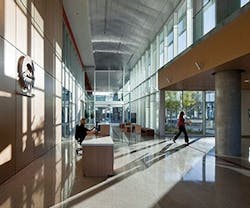Urban sprawl is often (and not-so-endearingly) referred to as the bane of our modern society—and rightfully so. Standing in stark contrast to smart growth, sprawling suburban communities have been linked to social ills that run the gamut from increased pollution, traffic congestion and obesity to segregation and increased reliance on fossil fuels, and city planners seemingly give little thought to historical context when approving land use plans for neighborhood development.
There are exceptions to the rule, however, and the city of Chandler, Ariz., is one of them. Settled in the 19th century, Chandler is representative of the “New West”—areas that have been predominantly agricultural but are now home to high-tech companies and the more affluent knowledge workers they employ. Officials envisioned the new city hall as a modern complex that would serve as a gathering destination for the nearly 250,000 residents of this community without abandoning its rich history.
The urban design and site strategy for the new Chandler City Hall began with the idea of creating connections between the existing civic campus and the historic downtown core. It was also important to reinforce pedestrian-friendly activity around Dr. A.J. Chandler Park by extending it south to the City Hall site. The project takes a radical departure from typical suburban planning by placing the new complex in the heart of Chandler’s historic downtown—a stark contrast to many communities that try to create “new” city centers in fast-growing areas.
“We talked to the client about the project—this idea from a metaphorical standpoint—trying to balance the culture of that community,” says Mark Roddy, AIA, principal and design director of SmithGroupJJR. “They have a long-standing history of agriculture and really being connected to the land, but Chandler is also a very high-tech community. Companies like Intel, Covants, Microchip Technologies and others are there, so there’s a really strong knowledge worker base. It’s interesting: you’ve got this mix of agriculture, ranchers and high-tech workers, so there’s a kind of dichotomy.”
As a result, the Phoenix offices of SmithGroupJJR designed an elegant, yet appropriate building to serve this diverse community. The 137,700-square-foot, multi-purpose complex creates a sense of place and identity to encourage activity and interaction between visitors, while also reflecting the surrounding terrain. The facilities include council chambers, administrative offices, a public television studio and a 330-space parking structure.
onceptually, the design unites the city’s past while acknowledging the future. “We really looked at the materiality of the building—we wanted to express something that felt like it was rooted in the landscape but also something that was very technology-driven,” Roddy notes. The stone exterior of the facility makes a clear connection to its natural surroundings, which is contrasted by a “glass box” office building that “floats” above on columns, he explains. “So there was this expression of the dichotomy of the two, but still having it all kind of woven together.”
The office tower has been oriented to maximize north and south exposure while minimizing east-west exposure. Passive shading strategies were utilized on the south and west facades to block direct heat gain during the summer months and allow for some penetration during the winter. Approximately 80 percent of the complex’s regularly occupied spaces are daylit, and glass abounds from the offices to the staircases, which are framed by products from Meltdown Glass.
“All the conference rooms have glass fronts; the offices have glass fronts—even the mayor’s office—so that there’s borrowed light throughout the entire space,” Roddy explains. “So it was obviously a very democratic kind of experience, but from a sustainability standpoint as well, it’s allowing views to daylight for everybody. That really was the focus of the office planning.”
Prior to the opening of the consolidated facility, Roddy says some of its client’s offices were leased and dispersed throughout the city; the council was meeting in a library space that doubled as a meeting hall. As a result, the council chambers became a focal point of the project, and are now an iconic centerpiece in the complex. Clad in translucent glass panels, the structure glows like a lantern at night.
“We actually referred to [the council chambers] as kind of the living room,” he recalls. The interior finishes, including perforated acoustic ceilings by Armstrong and bamboo wall paneling from Teragren give the space a hospitality-inspired aesthetic. “It goes back to the notion that they didn’t have a space that was truly dedicated as a council’s chambers. The warmness of the bamboo and the color of the fabric on the chairs, the carpet really all made it a comfortable, inviting space to have meetings and do business.”
The chambers were designed with flexibility in mind, and are meant to be a multi-use space, according to Roddy. That presented a unique challenge in terms of lighting strategies. While the space is primarily used for council meetings and committee gatherings, the council chambers are also opened up for small events including film screenings and musical performances—all of which have completely different lighting requirements.
“The council chambers are fairly complex in terms of lighting strategies. Each one of those [activities] has a different kind of lighting quality, and on top of that, council meetings are typically broadcast on television. So trying to balance out the quality of light that’s comfortable for people, and then have the appropriate lighting for broadcasting or filming television—they’re really two different things,” he points out.
Other dramatic lighting elements and the large-scale integration of art supported the city’s desire to convey a sense of community, safety and beauty. SmithGroupJJR collaborated with artist Ned Kahn, who combined science, art and technology to create an installation titled, “Turbulent Shade.” This original work of art, commissioned by the city, is actually a kinetic façade that moves with the wind while doubling as a second skin, shading the building from the desert sun.
According to Roddy, the installation is made up of a series of perforated stainless steel panels that are 6 inches wide by 21 inches long, held off on two studs that allow each of the panels to move independently. “So as the wind blows, the façade actually changes,” giving the building a dynamic appearance that is constantly evolving.
The city was also passionately committed to exploring sustainable design strategies for the new complex, which is seeking LEED-NC Gold certification, in order to set an example for the community.
“[Sustainable design is] really a new way of thinking,” says Roddy. “Most people probably think of architecture as shelter or just a place, and we’re really emerging in this time now where you really need to be thinking of architecture as a tool—our buildings as tools, or as instruments.”
The multi-story office tower is predicted to use 35 percent less energy than a similar new building, while also exploiting natural light. Creative water solutions respond to the desert region and have resulted in an overall potable water savings of 92 percent. The interiors feature underfloor air distribution, individual control of lighting, and a flexible, open office environment that improves indoor air quality and optimizes comfort for occupants.
Contrary to surrounding communities that have developed city functions in growing areas, Chandler redeveloped an existing urban site to promote density, pedestrian connections, and to “lead by example” for future development.
“Great buildings come from great clients,” Roddy says. “The client pushed us the whole way, and I think they have everything to do with this fantastic result.”
SOURCES:
back to top
|
acoustical system ceilings fabrics flooring furniture
|
glass interior walls lighting control systems lighting |
Solar Synergy masonry, concrete and stone millwork paints & finishes |
plumbing and water systems seating skylights special surfacing tiles wall coverings windows and doors |
CONTACT:
back to top
|
client project team |
structural engineer civil engineer general contractor |
landscape architect public art photogrphy |
About the Author
Robert Nieminen
Chief Content Director
Chief Content Director, Architectural Products, BUILDINGS, and interiors+sources
Robert Nieminen is the Chief Content Director of three leading B2B publications serving the commercial architecture and design industries: Architectural Products, BUILDINGS, and interiors+sources. With a career rooted in editorial excellence and a passion for storytelling, Robert oversees a diverse content portfolio that spans award-winning feature articles, strategic podcast programming, and digital media initiatives aimed at empowering design professionals, facility managers, and commercial building stakeholders.
He is the host of the I Hear Design podcast and curates the Smart Buildings Technology Report, bringing thought leadership to the forefront of innovation in built environments. Robert leads editorial and creative direction for multiple industry award programs—including the Elev8 Design Awards and Product Innovation Awards—and is a recognized voice in sustainability, smart technology integration, and forward-thinking design.
Known for his sharp editorial vision and data-informed strategies, Robert focuses on audience growth, engagement, and content monetization, leveraging AI tools and SEO-driven insights to future-proof B2B publishing.

